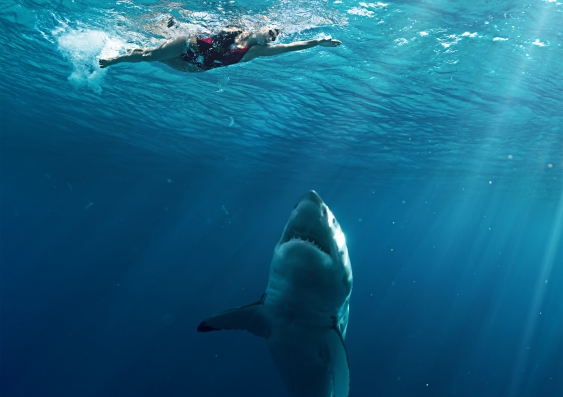It will take years to know whether NSW's shark nets are working
Shark attacks are so rare and variable, proving the effectiveness of shark nets in reducing attacks is no mean feat, writes James Smith.
Shark attacks are so rare and variable, proving the effectiveness of shark nets in reducing attacks is no mean feat, writes James Smith.

OPINION: Shark nets are being trialled at five locations in northern New South Wales in response to a recent spate of shark attacks in this area.
The goal of these nets is to reduce the number of encounters of sharks with humans. The nets may do this by catching large sharks, and possibly by changing the way sharks visit these beaches.
There has been some doubt as to the effectiveness of shark nets in reducing attacks, so it’s important we continue to evaluate their role in bather protection.
But unfortunately it’s not as straightforward as it sounds, and it could take years to find out whether the nets will truly work.
Shark attacks are very rare. According to the Australian Shark Attack File, 51 unprovoked attacks by white sharks have been recorded in NSW since 2006, 19 of them along the north coast (between Byron Bay and Evans Head).
There have undoubtedly been spikes in attacks over the last decade, especially in northern NSW, but the number of attacks has varied a lot between years and locations.
The problem is that when events (like shark encounters) are both rare and variable, it is very difficult to spot when there has been a genuine increase. And, crucially for the shark net trial, it is also difficult to tell whether policies are reducing them.
In the area of NSW where the shark nets will be trialled, between Broken Head and Evans Head, white shark attacks have ranged from zero to six per year in recent years. One way of getting an idea about how many attacks might occur in the future is to fit a statistical distribution to these data, and use this to predict the frequency at which attacks will occur (assuming the attack rate doesn’t change much).
In a hypothetical scenario in which the trialled shark nets are a success and reduce the attack rate by white sharks in the area by (say) 75%, our statistical distribution tells us that almost all years will have zero or one attack (see the red line below).
However, if the nets do nothing and the attack rate stays the same, we would still expect most years to have zero or one attack (the pink line below). This shows that it will be very difficult to know in the short term if the shark nets truly are reducing the risk of attack. This graph shows how difficult it can be to identify a reduction in risk, even by a large amount.
Even if there are zero attacks at a netted beach next year, that doesn’t necessarily tell us the net has worked, because statistically we would expect zero attacks in most years anyway. By the same token, if someone is bitten by a shark at one of the netted beaches, it doesn’t mean the nets aren’t effective. They may be greatly reducing the risk, just not eliminating it completely.
Because these encounters are so rare and variable, it will probably take years (rather than the six months planned for the trial) before there is enough evidence to show whether the nets have reduced attacks.
We also know very little about which factors influence encounters with large sharks. Without this information it is even harder to recognise whether the nets bring a decline in shark encounters.
In the above example, I used the recent history of attacks as the only guide to the future, but this is the most basic approach to exploring trends and assumes that recent history is a reliable indicator of the near future. A great way to improve this approach is to look for factors that can help explain why attacks vary between years – in essence basing our analysis on ecology rather than purely statistics.
The environment will almost certainly change the chance of a shark encounter. Factors like ocean temperature may have a big influence in determining when large sharks swim close to shore. The more of this “biological” information we have, the better we can account for variation in the number of shark attacks, and thus the better we will get at assessing whether policies like shark nets are working.
As described above, a six-month trial is not really long enough to learn anything meaningful about whether nets reduce shark attacks. It will provide other useful information, though, such as the likely impact on marine life. So we might find out whether the nets harm sharks, turtles, dolphins etc, but not whether they are making people any safer.
I am not suggesting that the trial won’t be useful – evaluating the impact on marine life is essential for assessing the costs of the nets. But what I am saying is that we need to avoid jumping to conclusions about whether they are “reducing the rate of unprovoked interactions with potentially dangerous sharks”. It will be years before we can attempt to answer that question.
In the meantime, there is much to be gained by increasing our understanding of how the environment influences shark distributions, by linking locations of tagged or caught sharks with the kinds of environments they inhabit. This will remove some of the guesswork in the “where and when” of shark attacks, and hopefully contribute to a more scientific approach to bather protection.
James Smith is a Research Fellow in Fisheries at UNSW.
This article was originally published on The Conversation and can be republished for free, online or in print, under Creative Commons licence. Read the original article.